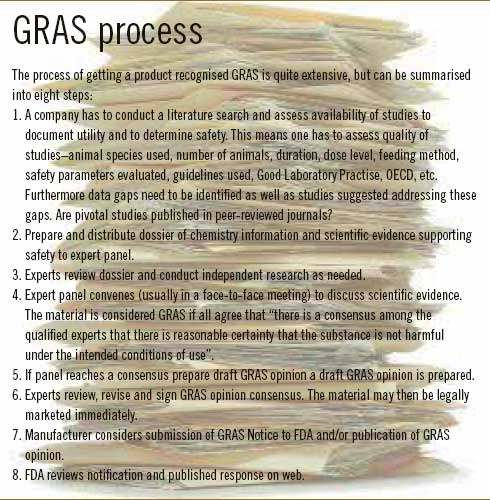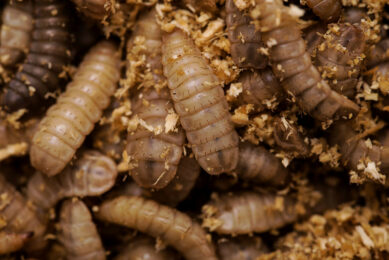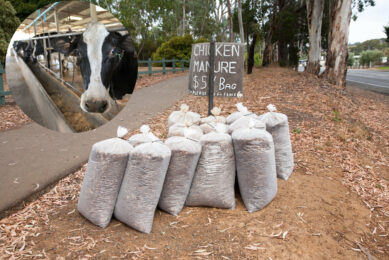Modern ‘GRAS’ feed ingredients fail administrative recognition

The US Food & Drug Administration (FDA) already in 1997 proposed rules for including feed ingredients in the Generally Recognized As Safe (GRAS) system. Only at the end of last year it asked for comments from the industry. GRAS would make the introduction of new feed ingredients to the American animal feed market much easier.
The ingredients used in animal feed in the US are regulated by the Center of Veterinary Medicine within the FDA as well as the State Feed Controllers. The State Feed Controllers follow the guidelines laid out in the official publication of the American Association of Feed Control Officials (AAFCO). In general, if the addition of an ingredient to animal feed cannot be justified by its role as a nutrient, it will be scrutinised to the level of a drug feed additive and will require the extensive testing associated with the approval of a drug feed additive. Under those procedures, persons – called “notifiers” – may submit to the agency notices of claims that a particular use of a food substance is Generally Recognized As Safe (GRAS), and thereby is exempt from other legal premarket-approval requirements as authorised under the federal Food Drug and Cosmetic Act (FFDCA). And if an ingredient is not listed as GRAS for animal feed in the Federal Registry, or listed by AAFCO, it cannot be used in feed formulations.
The continued approval of new, innovative feed ingredients is critical for the feed and pet food industries to maintain providing safe, healthy feed for livestock, poultry, aquaculture and pets. Therefore, the American Feed Industry Association (AFIA) recently submitted comments to the FDA regarding FDA’s final rule amending the procedures for substances Generally Recognized as Safe (GRAS).
FDA reopened the comment period in late 2010 to finalise the rule amending the procedures for GRAS. After 14 years of inaction on the proposed rule, this comment period was necessary to update feedback to the FDA regarding the proposed GRAS notification process. FDA’s Center for Veterinary Medicine (CVM) has only recently started to review GRAS submissions for new animal feed ingredients while the human food industry has had hundreds reviewed and allowed on the market.
“While the industry is still able to self-determine the GRAS status of a substance, it is in the best interest for all entities to work together. Finding a workable solution will ensure that the US feed industry continues to be the world leader in bringing novel ingredients to market to help the animal agriculture industries safely feed the growing population,” stated Leah Wilkinson, AFIA’s director of ingredients and state legislative affairs.
Stifling innovation
The US feed industry has a long history of providing safe ingredients in animal feed, but recognises the role that federal officials in the FDA-CVM and state feed control officials as part of AAFCO can play in reviewing these ingredients.
CVM has stated during several public forums that proof of utility (i.e., functionality) of an ingredient must be published. AFIA believes that an absolute requirement for proof and publication of utility is inappropriate and unnecessary. Although the association understands that an intended use must be described and supported in the notice, the pivotal issue is whether the ingredient is safe to feed to animals at the intended level. “Both industry and CVM resources could be better used demonstrating the safety of the intended use of the substance with a focus on establishing the worst-case exposure and relating it to available safety information in order to establish a margin of safety. As it stands, the requirement for and public documentation of the utility of an ingredient will predictably stifle innovation in the feed ingredient industry,” AFIA said in a statement.
AFIA also believes that CVM should accept safety data extrapolated from other species, instead of requiring separate tests for each species. “The additional cost and time alone will deter companies from pursuing new feed ingredients or more efficient ways to produce existing feed ingredients regardless of the well-established safety of these ingredients. CVM should recognise that good scientific procedures can prevail to allow the use of other data or information in the available literature to extrapolate the safety data from one species to another,” said Wilkinson.
AAFCO publication required
In the third main issue commented upon, AFIA believes that GRAS-notified substances reviewed by FDA without objection need to be listed in the AAFCO Official Publication. Without a listing in the Official Publication, most states will not allow these ingredients to be used. Therefore the association strongly encourages CVM to work with AAFCO and industry to create a new section in the AAFCO Official Publication for GRAS-notified substances that were reviewed by CVM and found to present a sufficient basis for a GRAS conclusion.
Not only the American feed millers urge FDA to hurry up and listen to practice, also the National Grain and Feed Association (NGFA) has urged (FDA) to finalise its proposed GRAS regulations. In response to FDA’s request for comments, the NGFA said it “strongly supports” the agency’s efforts to finalise its proposed voluntary GRAS-notification procedure.
NGFA recommendations
In response to FDA’s demand for comments on the proposed GRAS regulations NGFA said the FDA needs to incorporate the concept of studies being “generally available and accepted” within the description of the common-knowledge element. In doing so, the NGFA noted that such a concept is appropriate and consistent with the FFDCA. It also emphasised that studies should not necessarily need to be published in a peer-reviewed journal to be relevant and acceptable for the GRAS-notification process.
The government should include a provision in the final rule that makes notifiers clearly aware that they may at any time withdraw a notice during its evaluation by FDA. The NGFA stated that such a provision potentially would provide the affected notifier with an opportunity at a later date to appropriately resubmit a notice for which FDA initially has questions.
GRAS submissions typically should exclude trade secrets, yet provide enough detail to FDA concerning the manufacturing process so the agency may complete appropriately its safety assessment. However, the NGFA acknowledged that there may be limited situations in which submission of trade secret information is necessary to allow FDA to make an adequate safety assessment; if so, the NGFA said, such information should be subject to existing confidentiality protections. The parameters required by FDA to establish the proof of utility of a substance within the GRAS-notification process be limited to information necessary to conduct an appropriate safety assessment. However, the NGFA noted that it should not be necessary for the notifier to submit additional information to demonstrate the technical effect of the substance within animal food in cases where such an effect has no impact on food safety. According to NGFA the proposed 90-day timeframe to respond to a GRAS notice should be retained. Such a timeframe would provide an incentive to manufacturers to submit GRAS notices and use the notification process, thereby increasing the agency’s awareness of the composition of the ingredients used in animal food and providing an opportunity for FDA to review the safety parameters of such ingredients.
What is GRAS?
GRAS is an acronym for the phrase Generally Recognized As Safe. Under sections 201(s) and 409 of the Federal Food, Drug, and Cosmetic Act, “any substance that is intentionally added to food is a food additive, that is subject to premarket review and approval by FDA, unless the substance is generally recognised, among qualified experts, as having been adequately shown to be safe under the conditions of its intended use, or unless the use of the substance is otherwise excluded from the definition of a food additive”.
The opportunity for substances to gain GRAS recognition for use in animal food is based upon the 1958 food additives amendment to the FFDCA. To qualify for GRAS status, the specified use of the food substance is required to meet two necessary elements – a “technical” and a “common-knowledge” element. The technical element requires that available information about the food substance establish that it is safe for its intended use.
The common-knowledge element includes two facets: 1) the data and information relied upon to establish the technical element must be generally available; and 2) there must be a basis to conclude that there is consensus among qualified experts about the safety of the substance for its intended use.
There are three types of GRAS:
- GRAS affirmation by FDA meaning the substance is reviewed and approved by FDA, codified in the Federal Regulations. This is no longer applicable.
- GRAS self-affirmation. Here is no review by FDA, but qualified experts agree after review of the data. These can be challenged by FDA and may not be accepted by customers and state officials.
- GRAS notification (voluntary). This does not indicate “approval”, but indicates whether FDA CVM has any objection to the GRAS self-affirmation.
All three GRAS methods lead to a legal product on the US market, but there are exemptions. Substances are not GRAS, it is a particular use of the substance that is GRAS. For animal feeds, use of substances varies with the animal species, thus feed GRAS determinations must address intended use in the intended animal species as well as safety for each target species.
Eligibility for GRAS
Substances of natural biological origin that has been consumed for its nutritive properties before 1958 without detrimental effect for which no health hazard is known and has been modified by processes used after 1958 are eligible for GRAS.
Also if the substance has been significantly changed in composition by breeding or selection after 1958. Also qualified are distillates, isolates, extracts and concentration of extracts of GRAS substances.
The food additive definition is very broad, but it does not, include pesticides and colour additives (these are approved under another FDA premarket process), drugs and new animal drugs. It must be clear that intended use does not fall into drug category.
Intended use of a substance can be as a nutrient, such as essential nutrients (amino acids, fatty acids, vitamins, minerals, water, and in some cases, fibre). Also regulations for dietary supplements (DSHEA) do not apply to animal feed. Many of these substances fall in a grey area. According to the CVM Program Policy & Procedures Manual (Guide 1240.3605) when there is improved productivity or the substance prevents disease, is a treatment or mitigates a disease it is considered a drug.
In contrast to human food GRAS the utility of the ingredient is necessary for animal feed GRAS. It must demonstrate the utility or efficacy of intended use e.g. it can have a technical effect on the feed as a preservative, emulsifier or pelleting aid, or it improves food desirability and preference through a flavour or aroma.
Food versus drug
According to FDA’s Center for Veterinary Medicine (CVM) a food is something that provides nutrition, taste, or aroma. If food affects the structure or function of the body, it does so by these properties (i.e. provide nutrients such as calcium for proper bone structure or taurine for healthy heart function in cats). A drug is an article intended for use in the diagnosis, cure, mitigation, treatment or prevention of disease, or an article intended to affect the structure or function of the body other than food. If a substance affects the structure or function of the body apart from its nutritive value, (i.e. improvement in joint function) it may be deemed a drug. Structure/function effects extending beyond the food umbrella also include claims for improved or increased production and performance, or alteration or improvement in function.
Conclusions
There are specific requirements to determine whether an ingredient is or can be considered GRAS for a specific use in animal feed. Data requirements are extensive since they must have both safety and efficacy data. A general recognition of safety data is also required. The process may represent faster route to market. A product can legally be put on the market once self-affirmed, but in reality it may need notification for acceptance. The process is still in early stages for the feed industry, with no notifications yet.
Source: Cantox, AFIA, NGFA, FDA











